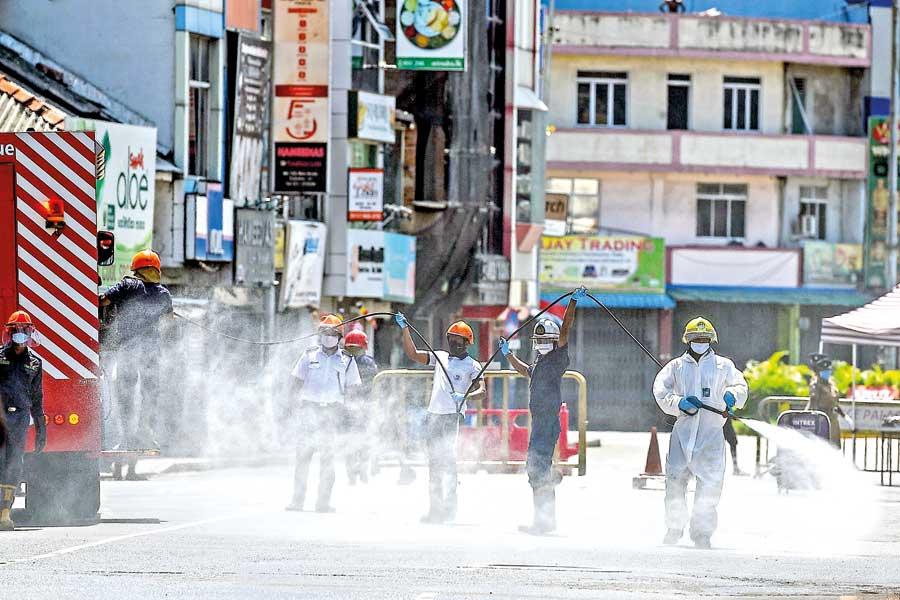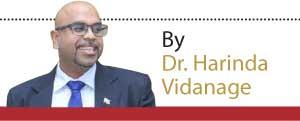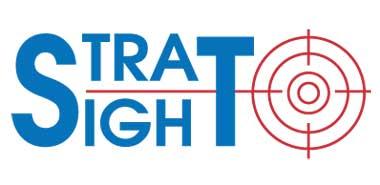Reply To:
Name - Reply Comment

Firefighters spray disinfectant to sanitize a road as a preventive measure against the spreading of COVID-19 pandemic in Colombo. (File Photo)
Ever since the COVID-19 outbreak struck Sri Lanka about two months ago, a couple of narratives dominated our life. They were mainly driven as coping mechanisms and containment efforts. Amidst discussions of social distancing, isolation, battle against COVID-19 the real yearning has always been about the post COVID-19  situation and a new normal will set in.
situation and a new normal will set in.
Whilst there are multitude of analysis about what comes after, they all remain either based on scientific modelling, data analysis or historical transformational analysis. Thus, the common term that captures this condition is, New Normal. This week’s analysis is on the concept of new normal, inspired by a student of mine who asked me why I do not write about it? Indoosan Shanthakumaran here goes my take.
The idea of the new normal and its narrative strongly embedded in both policy and popular lexicon as a postmortem analysis of the financial crisis of 2008. Since the establishment of the new global order in vastly helm and shaped by the global West in 1945 at the end of the second world war, 2008 was the year that started shaking that stability. The crash of 2008 led to the unravelling of the institutions that made up the global governance network.
Ten years after 2008,COVID-19 outbreak seems to be completing the destabilizing phase, the classic high point of this unravelling is when the incumbent US President attacks the World Health Organization (WHO), accusing it to be a functioning Chinese Pawn. However you look at it, it is poignantly telling of the fact of the beginning of the end of a system that managed global affairs and set bench marks of diplomatic interaction since 1945. The decay of the old system and one yet to be born, If one was an avid Marxist, we are living in the Gramscian times of interregnum.
COVID-19 impact is not similar to the economic recession of 2008 neither is it totally parallel with the 1918 infamous Spanish Flu, which is unfairly coined to the Spanish as it was a global flu which only the Spanish press had the freedom to report, hence it was christened as the Spanish Flu.
Yet it did have a devastating impact on states as well as the global order. The outbreak came at a period of serious global instability in the aftermath of the first world war, a failed effort to create global governance in the form of the league of nations and then within the span of two decades a massive financial crisis. The financial crisis generated political outcomes leading to rise of nationalist and warlike leadership that took the world to the largest total war mankind as ever seen.
Thus, while the flu was not the significant factor that affected massive chaos and destruction in the first three decades of the 20th century, it indeed came at a time of great rivalries. All this chaos was contained with certain consensus after 1945. The stability that was achieved and frameworks that underpinned it has entered a serial decay since 2008 and the world is heading back into uncharted territories, and we are living in its aftershocks. Is COVID-19 leading us to a new normal or is it leading us to a phase of chaos for something new to emerge amidst all these crises that has plagued us in the last decade?
The new normal is currently a pure abnormal where all pre-COVID-19 crises such as geopolitics, trade wars, global warming, nationalism, racism, and decay of democracy has intertwined with the outbreak. Prof. Joseph Nye recently observed in a piece, where he frustratingly argues that the world misses transformational leaders and instead from both sides of the global powers from USA to China the leadership is hellbent on brandishing nationalism and rivalry at the cost of global cooperation.
At a time when the world is desperately in need of leaders who can harmonize and respond to global crises, we are left with narratives that blame each other. This adversarial relationship will lead to more and more conspiracy theories hatched by both states and people will be sucked into divisive narratives which is not going to fix anything and create a new normal that is beneficial for humankind.
A fundamental pillar of a new normalcy will be a COVID-19 vaccine that is globally available and with convenient access to rich and poor states alike. To date this remains an ideal, even prior to the COVID-19 outbreak, nearly 800 million people on Earth go to bed hungry, and out of these nearly 90 million people are extremely vulnerable. Global governance mechanisms and programs have consistently struggled in the recent past. The above- mentioned global ruptures and rivalries have spawned suffering for many.
mentioned global ruptures and rivalries have spawned suffering for many.
If we are seriously hoping for an anti COVID-19vaccine it is wishful thinking at this current conjuncture , as such a vaccine development program needs a serious global commitment and global cooperation, with US accusing China of making the Virus and China accusing US of its own inability to deliver a minimum standard of health care system that is accessible to any American, the prospects of collaboration on a vaccine is bleak.
The importance of ending the outbreak lies not just on the development of a vaccine but making billions of doses that are readily available. Essentially the vaccine needs to be declared a public good. There are efforts under way by states and pharmaceutical industries to develop an effective vaccine, without a real global governance mechanism at play with no real global leadership such a solution unfortunately is far over the horizon.
What policy makers in Sri Lanka should understand out of this chaotic situation, is the stark realities of a world in transition, a world divided. With supply chains of production disrupted and contrasting and contending narratives engulfing mainstream news media how do we shape our new normal?
Today May 11, Sri Lanka is trying to head for a new normal, the policies government adopts in this short-term contingency needs to link with long term resilience for economic stability to social stability. As the trajectory of the outbreak is still unknown, the world is internally opening up, external boundaries remain closed, one major lesson from the Spanish flu outbreak of 1918 is that it unfolded in three waves, the second was the deadliest and the most global.
If we pretend to walk into a bubble of a new normal, we are heading for peril. The New Zealand Premier JacindaArden, while announcing an internal victory over COVID-19 reiterated that country will remain closed to the rest of the world for a much longer period, even resisting opening to Australia. What we achieved was a tactical victory by efficiently carrying out isolation a credit the political leadership, health authorities and the military share. Yet the downside is that it also elongates the effect, it is a defensive tactical manoeuvre, only through mass testing, outbreak tracing and ultimately vaccination is victory possible.
Temporary lapses in cases under a lockdown should not be promoted as a new normal. The new normal is something everyone must work hard to achieve; it is constructed both locally and globally. A positive new normal is built on leadership and responsible citizenry neither can wait for the other, it is a test of our values and commitments, all Sri Lankans need to walk the talk, out of the comfort zones of social media heroism. This is an educator’s reflections to a student’s query, that is relevant to all of us, the new normal should be a Sri Lankan social contract, not a foreign transplant.